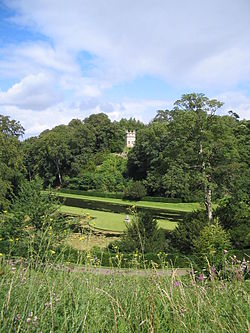Studley Royal Water Garden
| Studley Royal Park with the ruins of Fountains Abbey | |
|---|---|
|
UNESCO world heritage |
|

|
|
| Studley Royal Water Garden with octagonal lookout tower |
|
| National territory: |
|
| Type: | Culture |
| Criteria : | (i) (iv) |
| Reference No .: | 372 |
| UNESCO region : | Europe and North America |
| History of enrollment | |
| Enrollment: | 1986 (session 10) |
Studley Royal Water Garden is a Georgian water garden in North Yorkshire in Northern England .
Since 1986, the garden is part of the UNESCO - World Heritage Site "Studley Royal Park with the ruins of Fountains Abbey ."
history
In 1693, John Aislabie , MP and later Chancellor of the Exchequer of the Whig Administration, bought an overgrown forest valley along the small river Skell. After the financial scandal over the South Seas Society in 1720, Aislabie not only lost his political offices, but also his honorary rights. Aislabie was declared one of the main culprits of this bubble for introducing the South Seas Society's bill to take over a large portion of the UK's national debt. He retired to Yorkshire and devoted himself exclusively to the design of the Studley Royal water garden, which he had begun in 1718. After his death in 1742, his son William continued his work, bought the area of Fountains Abbey and integrated it with a deer park into the landscape garden .
garden
Studley Royal was designed by its owner, John Aislabie, under the influence of John James' translation of " La Théorie et la pratique du jardinage " by Antoine-Joseph Dézallier d'Argenville . This work on the French baroque garden follows on from the garden art of André Le Nôtres . Despite these influences, a garden was created that no longer exclusively corresponded to the baroque shape in its overall concept. Studley Royal is a garden of transition between baroque and landscape styles. It is the most important garden in England from the early 18th century.
layout
The lower canal forms the main axis running approximately in north-south direction, which is aligned with the "How Hill Tower" in the south of the park. The Upper Canal forms a second axis, which connects the Palladian “Banqueting House” with the “Tent Hill”, which Aislabie artificially enlarged in 1724. The canal began at the "Rustic Bridge". This formed the border of Aislabie's land holdings until in 1724 a lease gave him the opportunity to include the land south of Studley in the water garden. A reservoir, the Crescent Pond, was created. To the north, the garden is closed off by a formal balustrade and cascade , which forms the link between the artificial lake in the valley and the ruins of Fountains Abbey on the hill. The extensive circular water surface of the moon pond is the center of the garden. It is flanked by two arched ponds. The lawns of the garden were bordered with yew hedges and the slopes of the valley were planted with beech and elm trees.
Buildings and art
In the 1830s, mainly ornamental buildings and sculptural decorations were added to the garden. This is how the entrance pavilions, a “Temple of Fame” called Monopteros , the former orangery was converted into the “Banqueting House”, and on the opposite side of the canal, the octagonal observation tower from 1738 and a Venus temple with a domed roof were built. A Doric temple of Hercules at the moon pond was converted into a "temple of piety" by Aislabie's son. The Anne Boleyn Seat, also known as The Surprise View, offers a great view of the ruins of Fountains Abbey and the Crescent Pond. Old paintings show that there was a statue of Henry VIII's second wife at this point ; according to the legends, this statue carried its head under its arm and turned its back to the abbey. At the moon pond, lead statues of Bacchus , Galen and Neptune serve as eye-catchers. Further design elements in the Studley Royal water garden are the serpentine tunnel and the hermit grotto, a popular detail in Georgian gardens.
literature
- G. Cooper, G. Taylor, C. Boursnell: Water Gardens . About the magic of water in English gardens and parks. Gerstenberg Verlag, Hildesheim 1990, ISBN 3-8067-2052-5 .
Web links
- Fountains Abbey and Studley Royal Water Garden on nationaltrust.org.uk (English)
- World Heritage Studley Royal Park including the Ruins of Fountains Abbey on the UNESCO website
Individual evidence
- ↑ John James (approx. 1672–1746), architect, surveyor and carpenter, wrote the first English translation of d'Argenville's book: The theory and practice of gardening, Maurice Atkins, London 1712.
Coordinates: 54 ° 6 ′ 41 ″ N , 1 ° 34 ′ 54 ″ W.
